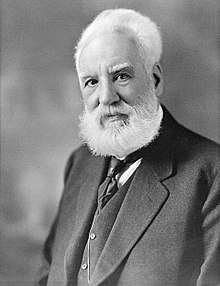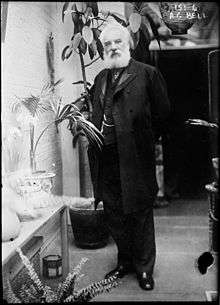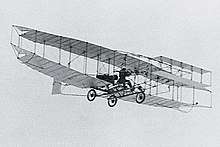அலெக்சாண்டர் கிரகாம் பெல்
அலெக்ஸாண்டர் கிரகாம் பெல் ( Alexander Graham Bell, மார்ச் 3, 1847 - ஆகஸ்ட் 2, 1922) ஓர் அறிவியலாளர், பொறியாளர், கண்டுபிடிப்பாளர், ஆசிரியர் மற்றும் அறிவியல் அறிஞர் ஆவார். தொலைபேசியைக் கண்டுபிடித்ததற்காக அறியப்படுகிறார். தனது இளமையில் பிரித்தானியக் குடிமகனாக இருந்தார். பின்னர் அமெரிக்கக் குடியுரிமை பெற்றார்."[1][2] இவரது தாயாரும் மனைவியும் செவிடராதலினால் இவரது ஆய்விற்கு இது ஓர் உந்துசக்தியாக அமைந்திருக்கலாம்.[3] இவரது ஆய்வுகள் ஊடாக 1876 ஆம் ஆண்டு தொலைபேசி உருவாக்கப்பட்டது. இவர் பெல் தொலைபேசி நிறுவனத்தின் நிறுவனரும் ஆவார்.
| அலெக்சாண்டர் கிரகாம் பெல் | |
|---|---|
 | |
| பிறப்பு | மார்ச் 3, 1847 பிரிட்டன் |
| இறப்பு | ஆகத்து 2, 1922 (அகவை 75) கனடா |
| இறப்பிற்கான காரணம் | நீரிழிவு நோய் சிக்கல்கள் |
| பணி | கண்டுபிடிப்பாளர் விஞ்ஞானி பொறியாளர் பேராசிரியர் (போஸ்டன் பல்கலைக்கழகம்) |
| அறியப்படுவது | தொலைபேசி கண்டுபிடிப்பு |
| கையொப்பம் | |
பணிகள்
கிரகாம் பெல்லின் குடும்பம் கனடாவிற்குக் குடி பெயர்ந்தது.[13] போஸ்டன் நகரத்தில் வசித்த போது காது கேளாதோர் பள்ளி ஆசிரியர்களுக்குப் பயிற்சி தருவதற்காக பெல் ஒரு பள்ளிக் கூடத்தை ஏற்படுத்தினார்.[14][15][16] அதில் பேச்சுமுறை பற்றிய அடிப்படைகளைக் கற்பித்தார்[17] .அவரது ஆய்வுமுறை, அறிவாற்றல் எங்கும் பரவியதால், பாஸ்டன் பலகலைக் கழகம் பேச்சு அங்கவியல் பேராசிரியராக இவரை பணியில் அமர்த்தியது.
ஆய்வு
பியானோவில் ஒலி எழுப்பி மின்சாரம் மூலமாக அந்த இசையை ஒரு குறிப்பிட்ட தொலைவுக்கு அணுப்பினார் பெல். தந்தி முறையில் வெறும் ஒலிகள் மட்டுமே அனுப்பப்பட்டன. பேச்சுகளையும் அந்த முறையில் அனுப்பலாமே என்று கிரகாமுக்கு 18 வயதிலேயே தோன்றியது. அதனால் அந்த முயற்சிகளில் ஈடுபடார்[18][N 3] . அக்காலத்தில் மனிதனின் பேச்சொலிகளை ஓரிடத்திலிருந்து மற்றோரிடத்திற்கு தந்திகள் மூலம் அனுப்பப்பட்டு வந்தது. அந்த முறைகள் இவருடைய ஆராய்ச்சிக்கு மிகவும் உதவியாயிருந்தன. 1875 இல் இந்த முயற்சிகள் ஓரளவு வெற்றி பெற்றன. முதலில் தெளிவில்லாத பேச்சொலிகளை அனுப்ப முடிந்தது.
1876 ஆம் ஆண்டு உலகின் முதல் தொலைபேசி பேசியது பெல் அவருடைய உதவியாளர் வாட்சன்[20] என்பவரிடம் பேசினார். அவர் முதலில் தொலைபேசியில் பேசிய சொற்றொடர் " வாட்சன் இங்கே வாருங்கள். உங்களைக் காண வேண்டும்."(Watson, come here, I want to see you)என்பதுதான்.[21] இந்த சொற்களை வாட்சனால் தெளிவாகக் கேட்க முடிந்தது.[22] ஆனால் பெல் கண்டுபிடித்த தொலைபேசியைப் பற்றி யாரும் அக்கறை கொள்ளவில்லை அதனால் அவர் மிகவும் சோர்வடைந்தார். பிலெடெல்பியாவில் நடைபெற்ற ஒரு கண்காட்சியில் தனது தொலைபேசியைப் பார்வைக்கு வைத்தார். அங்கு வந்த பிரேசில் நாட்டு மன்னர் அதை வியப்போடு எடுத்துப் பயன்படுத்திய பின்னர் தான் தொலைபேசியின் பெருமை எங்கும் பரவியது. அமெரிக்காவில் உள்ள தனது மாமனாரின் உதவியுடன் 1876 மார்ச்சு 7 ஆம் தேதி தொலைபேசிக்கான காப்புரிமையைப் பெற்றார்.[23] [N 4][N 5][25][26]
1877 இல் தன் உதவியாளர் வாட்சனுடன் சேர்ந்து "பெல் தொலைபேசி கம்பனி" என்ற பெயரில் தொலைபேசி நிறுவனம் ஒன்றை நிறுவினார். தொலைபேசியைக் கண்டுபிடித்ததற்காக பிரெஞ்சு அரசு அவருக்கு வழங்கிய 50,000 பிராங்க் பரிசுத் தொகையைக் கொண்டு வோல்டா ஆய்வுச் சாலை (Volta Laboratory) என்ற பெயரில் ஓர் அமைப்பை நிறுவினார்.[27]
கண்டு பிடிப்புகள்

பெல் தொலைபேசியுடன் மட்டும் நின்றுவிடவில்லை. அரசு நிறுவனத்தின் மூலம் பொட்டோ போன்[28][29][30], ஆடியோ மீட்டர்[31][32][33][34], மெட்டல் டிடக்டர்[35], இன்டக்ஷன் பேலன்ஸ், வாக்ஸ் ரிகார்டிங் சிலிண்டர், கிராமபோன் போன்ற கருவிகளைக் கண்டு பிடித்தார். பெல் விமானம் கண்டு பிடிக்கும் முயற்சியிலும் ஈடுபட்டார். ஆனால் அது அவருக்கு வெற்றி தரவில்லை. ஆனால் சில கண்டுபிடிப்புகளைச் செய்தார்.

விமானத்தின் எய்லிரான் என்ற பகுதியைக் கண்டுபிடித்தவர் பெல் ஆவார். பிற்காலத்தில் கடல் விமானத்தைச் சீர்திருத்தி அமைப்பதில் வெற்றி கண்டார்.[36] ஆடுகள் வளர்க்கும் முயற்சியில் புதுமையைப் புகுத்தினார். ஒவ்வொரு முறையும் இரட்டைக் குட்டிகளை ஈடும் பெண் ஆடுகளை உருவாக்கவும் திட்டமிட்டார். பாலைவனங்களில் நாடுகாண முற்படும் படைவீரர்களுகு, காற்றிலுள்ள மிகுந்த ஈரத்தை வடிகட்டி உதவக் கூடிய அரிய கருவியைக் கண்டுபிடித்தார். காது கேளாதோருக்குப் பேச்சுப் பயிற்சியை வளர்ப்பதற்கான சங்கம் ஒன்றை நிறுவினார்[37]. கண் தெரியாதவர்களுக்குப் பிரெய்ல் முறையைக் கண்டு பிடித்த ஹெலன் கெல்லருக்கு பெல் பல உதவிகளைச் செய்துள்ளார்.[38] ஒலியியல் அடிப்படையில் உலக ஆங்கிலம் என்பதை உருவாக்க வேண்டும் என்பதில் ஆர்வம் காட்டினார். தனிப்பட்ட முறையிலும், பிற அறிவியலறிஞர்களுடன் சேர்ந்தும் 59 கண்டுபிடிப்புகளுக்கான காப்புரிமையை பெல் பெற்றுள்ளார் என்பது அவருடைய வரலாற்றில் மிக முக்கியமான அம்சமாகும்.
சிறப்புகள்
- 1882 இல் அமெரிக்கக் குடியுரிமை பெற்றார்.
- 1888 இல் உலக புவியியல் கழகத்தை(National Geograph Society) ஆரம்பித்த உறுப்பினர்களில் ஒருவராகவும், அந்தக் கழகத்தின் இரண்டாவது தலைவராகவும் விளங்கினார்.[39] He has been described as one of the most influential figures in human history.[40]
- பிரெஞ்சு அரசு வழங்கிய 'லெஜியன் ஆப் ஆனர்'(Legion of Honour) விருது
- Acedemic Francise விருது[41]
- வோல்டா பரிசு[42][43][44][45][46][47]
- ராயல் சொசைட்டி ஆப் ஆர்ட்ஸ்(லண்டன்),
- ஆல்பெர்ட் பதக்கம்(1902)
- உர்ஸ்பர்க் பல்கலைக் கழகம் வழங்கிய முனைவர் பட்டம்
- எடிசன் பதக்கம்(1914)
போன்ற பல்வேறு சிறப்புகளையும் விருதுகளையும் பெற்றார்.
மறைவு
அமெரிக்காவில் உள்ள பாடக் என்ற ஊரில் 1922 ஆம் ஆண்டு ஆகஸ்ட் மாதம் 2 ஆம் தேதி அலெக்சாண்டர் கிரகாம் பெல் காலமானார்.[48] அவர் மறைந்த தினத்தன்று அமெரிக்காவில் உள்ள தொலைபேசிகள் அனைத்தும் 5 நிமிடங்கள் நிறுத்தப்பட்டு அஞ்சலி செலுத்தப்பட்டது.[49]
காப்புரிமைகள்
- U.S. Patent 1,61,739 Improvement in Transmitters and Receivers for Electric Telegraphs, filed March 1875, issued April 1875 (multiplexing signals on a single wire)
- U.S. Patent 1,74,465 Improvement in Telegraphy, filed February 14, 1876, issued March 7, 1876 (Bell's first telephone patent)
- U.S. Patent 1,78,399 Improvement in Telephonic Telegraph Receivers, filed April 1876, issued June 1876
- U.S. Patent 1,81,553 Improvement in Generating Electric Currents (using rotating permanent magnets), filed August 1876, issued August 1876
- U.S. Patent 1,86,787 Electric Telegraphy (permanent magnet receiver), filed January 15, 1877, issued January 30, 1877
- U.S. Patent 2,35,199 Apparatus for Signalling and Communicating, called Photophone, filed August 1880, issued December 1880
- U.S. Patent 7,57,012 Aerial Vehicle, filed June 1903, issued April 1904
அடிக்குறிப்பு
- Bell typically signed his name in full on his correspondence.
- "Alexander M. Bell Dead. Father of Prof. A.G. Bell Developed Sign Language for Mutes." த நியூயார்க் டைம்ஸ் Tuesday, August 8, 1905.
- In later years, Bell described the invention of the telephone and linked it to his "dreaming place".
- A copy of a draft of the patent application is shown, described as "probably the most valuable patent ever."
- Quote: "He thought he could harness the new electronic technology by creating a machine with a transmitter and receiver that would send sounds telegraphically to help people hear."[24]
மேற்கோள்கள்
- Gray 2006, p. 228.
- Reville, F. Douglas. "History of the County of Brant: Illustrated With Fifty Half-Tones Taken From Miniatures And Photographs." Brantford Historical Society, Hurley Printing, Brantford, Ontario, 1920, p. 319. Retrieved from Brantford.Library.on.ca, May 4, 2012.
- Bruce 1990, p. 419.
- Petrie 1975, p. 4.
- "Call me Alexander Graham Bell." fi.edu. Retrieved: July 28, 2010.
- Groundwater 2005, p. 23.
- "Time Line of Alexander Graham Bell." memory.loc.goiv. Retrieved: July 28, 2010.
- Gray 2006, p. 8.
- Petrie 1975, p. 7.
- Mackay 1997, p. 31.
- Groundwater 2005, p. 30.
- Bruce 1990, pp. 297–299.
- Petrie 1975, p. 10.
- Petrel 1975, p. 15.
- Town 1988, pp. 12–13.
- Bruce 1990, p. 74.
- Bruce 1990, p. 37.
- Alexander Graham Bell 1979, p. 8.
- Fitzgerald, Brian. "Alexander Graham Bell: The BU Years." B.U. Bridge, Vol. V, No. 5, 14 September 2001. Retrieved: 28 March 2010.
- Hubbard's financial support to the research efforts fell far short of the funds needed, necessitating Bell to continue teaching while conducting his experiments.[19] Bell was so short of funds at times that he had to borrow money from his own employee, Thomas Watson. Bell also sought an additional CAD$150 from the former Premier of Canada, George Brown, in exchange for 50% of the patent rights in the British Empire (Brown later retracted his offer to patent the telephone in the U.K. for fear of being ridiculed). The Bell Patent Association, composed of Hubbard, Sanders and Bell and which would become the precursor of the Bell Telephone Company (and later, AT&T
- "Bell's Lab notebook I, pp. 40–41 (image 22)." loc.gov. Retrieved: July 28, 2010.
- MacLeod 1999, p. 12.
- MacLeod 1999, pp. 12–13.
- Black 1997, p. 18.
- வார்ப்புரு:Patent
- MacLeod 1999, p. 19.
- "Letter from Mabel Hubbard Bell, February 27, 1880." Library of Congress, Alexander Graham Bell Family Papers. Retrieved: April 5, 2009. Note (N.B.): The last line of the typed note refers to the future disposition of award funds: "... and thus the matter lay till the paper turned up. He intends putting the full amount into his Laboratory and Library".
- Bruce 1990, p. 336.
- Jones, Newell. "First 'Radio' Built by San Diego Resident Partner of Inventor of Telephone: Keeps Notebook of Experiences With Bell." San Diego Evening Tribune, July 31, 1937. Retrieved from the University of San Diego History Department website, November 26, 2009.
- Phillipson, Donald J.C., and Laura Neilson. "Bell, Alexander Graham." The Canadian Encyclopedia online. Retrieved: August 6, 2009.
- Carson 2007, pp. 76–78.
- Bruce 1990, p. 338.
- Groth, Mike. "Photophones Revisted." Amateur Radio magazine, Wireless Institute of Australia, Melbourne, April 1987, pp. 12–17 and May 1987, pp. 13–17.
- Mims 1982, p. 11.
- Grosvenor and Wesson 1997, p. 107.
- Phillips 1977, pp. 96–97.
- Miller and Branson 2002, pp. 30–31, 152–153.
- Petrie 1975, p. 17.
- "National Geographic Mission." nationalgeographic.com. Retrieved: July 28, 2010.
- Hart 2000, p. 222.
- Crosland, Maurice P. "Science Under Control: The French Academy of Sciences, 1795–1914". Cambridge University Press, 1992. As cited by James Love in "KEI Issues Report on Selected Innovation Prizes and Reward Programs: The Volta Prize For Electricity." Knowledge Ecology International, March 20, 2008, p. 16. Retrieved: January 5, 2010.
- Davis. John L. "Artisans and savants: The Role of the Academy of Sciences in the Process of Electrical Innovation in France, 1850–1880." Annals of Science, Volume 55, Issue 3, July 1998, p. 301. Retrieved from InformaWorld.com, January 5, 2010.
- "Honors to Professor Bell." Boston Daily Evening Traveller, September 1, 1880, Library of Congress, Alexander Graham Bell Family Papers. Retrieved: April 5, 2009.
- "Volta Prize of the French Academy Awarded to Prof. Alexander Graham Bell, September 1, 1880." Library of Congress, Alexander Graham Bell Family Papers. Retrieved: April 5, 2009.
- "Telegram from Grossman to Alexander Graham Bell, August 2, 1880." Library of Congress, Alexander Graham Bell Family Papers. Retrieved: April 5, 2009.
- "Telegram from Alexander Graham Bell to Count du Moncel, 1880." Library of Congress, Alexander Graham Bell Family Papers. Retrieved: April 5, 2009.
- "Letter from Frederick T. Frelinghuysen to Alexander Graham Bell, January 7, 1882." Library of Congress, Alexander Graham Bell Family Papers. Retrieved: April 5, 2009.
- Gray 2006, p. 419.
- Osborne, Harold S. "Biographical Memoir of Alexander Graham Bell, 1847–1922." National Academy of Sciences of the United States of America, Bibliographical Memoirs, Volume XXIII, First Memoir. Annual Meeting presentation, 1943, pp. 18–19.
துணை நூல்கள்
- Alexander Graham Bell (booklet). Halifax, Nova Scotia: Maritime Telegraph & Telephone Limited, 1979.
- Ayers, William C., Therese Quinn and David Stovall, eds. The Handbook of Social Justice in Education. London: Routledge, 2009. ISBN 978-0-80585-928-7.
- Bell, Alexander Graham. The Question of Sign-Language and The Utility of Signs in the Instruction of the Deaf—Two papers. Washington, D.C.: Sanders Printing Office, 1898.
- Bethune, Jocelyn. Historic Baddeck (Images of our Past series). Halifax, Nova Scotia, Canada: Nimbus Publishing, 2009. ISBN 978-1-55109-706-0.
- Bruce, Robert V. Bell: Alexander Bell and the Conquest of Solitude. Ithaca, New York: Cornell University Press, 1990. ISBN 0-8014-9691-8.
- Black, Harry. Canadian Scientists and Inventors: Biographies of People who made a Difference. Markham, Ontario, Canada: Pembroke Publishers Limited, 1997. ISBN 1-55138-081-1.
- Boileau, John. Fastest in the World: The Saga of Canada's Revolutionary Hydrofoils. Halifax, Nova Scotia, Canada: Formac Publishing Company Limited, 2004. ISBN 0-88780-621-X.
- Dunn, Andrew. Alexander Graham Bell (Pioneers of Science series). East Sussex, UK: Wayland (Publishers) Limited, 1990. ISBN 1-85210-958-0.
- Eber, Dorothy Harley. Genius at Work: Images of Alexander Graham Bell. Toronto, Ontario, Canada: McClelland and Stewart, 1982. ISBN 0-7710-3036-3.
- Evenson, A. Edward. The Telephone Patent Conspiracy of 1876: The Elisha Gray — Alexander Bell Controversy. Jefferson, North Carolina: McFarland Publishing, 2000. ISBN 0-7864-0138-9.
- Gray, Charlotte. Reluctant Genius: Alexander Graham Bell and the Passion for Invention. New York: Arcade Publishing, 2006. ISBN 1-55970-809-3.
- Grosvenor, Edwin S. and Morgan Wesson. Alexander Graham Bell: The Life and Times of the Man Who Invented the Telephone. New York: Harry N. Abrahms, Inc., 1997. ISBN 0-8109-4005-1.
- Groundwater, Jennifer. Alexander Graham Bell: The Spirit of Invention. Calgary, Alberta, Canada: Altitude Publishing, 2005. ISBN 1-55439-006-0.
- Lusane, Clarence. Hitler's Black Victims: The Historical Experiences of Afro-Germans, European Blacks, Africans, and African Americans in the Nazi Era. Hove, East Sussex, UK: Psychology Press, 2003. ISBN 978-0-415932-950.
- Hart, Michael H. The 100: A Ranking of the Most Influential Persons in History. New York: Citadel, 2000. ISBN 0-89104-175-3.
- Mackay, James. Sounds Out of Silence: A life of Alexander Graham Bell. Edinburgh: Mainstream Publishing Company, 1997. ISBN 1-85158-833-7.
- MacKenzie, Catherine. Alexander Graham Bell. Whitefish, Montana: Kessinger Publishing, 2003. ISBN 978-0-7661-4385-2.
- MacLeod, Elizabeth. Alexander Graham Bell: An Inventive Life. Toronto, Ontario, Canada: Kids Can Press, 1999. ISBN 1-55074-456-9.
- Matthews, Tom L. Always Inventing: A Photobiography of Alexander Graham Bell. Washington, D.C.: National Geographic Society, 1999. ISBN 0-7922-7391-5.
- Micklos, John Jr. Alexander Graham Bell: Inventor of the Telephone. New York: Harper Collins Publishers Ltd., 2006. ISBN 978-0-06-057618-9.
- Miller, Don and Jan Branson. Damned For Their Difference: The Cultural Construction Of Deaf People as Disabled: A Sociological History. Washington, D.C.: Gallaudet University Press, 2002. ISBN 978-1-56368-121-9.
- Mims III, Forest M. "The First Century of Lightwave Communications." Fiber Optics Weekly Update(Information Gatekeepers), February 10–26, 1982, pp. 6–23.
- Mullett, Mary B. The Story of A Famous Inventor. New York: Rogers and Fowle, 1921.
- Parker, Steve. Alexander Graham Bell and the Telephone(Science Discoveries series). New York: Chelsea House Publishers, 1995. ISBN 0-7910-3004-0.
- Petrie, A. Roy. Alexander Graham Bell. Don Mills, Ontario: Fitzhenry & Whiteside Limited, 1975. ISBN 0-88902-209-7.
- Phillips, Allan. Into the 20th Century: 1900/1910 (Canada's Illustrated Heritage). Toronto, Ontario, Canada: Natural Science of Canada Limited, 1977. ISBN 0-919644-22-8.
- Ross, Stewart. Alexander Graham Bell (Scientists who Made History series). New York: Raintree Steck-Vaughn Publishers, 2001. ISBN 0-7398-4415-6.
- Shulman, Seth. The Telephone Gambit: Chasing Alexander Bell's Secret. New York: Norton & Company, 2008. ISBN 978-0-393-06206-9.
- Toward, Lilias M. Mabel Bell: Alexander's Silent Partner. Toronto, Ontario, Canada: Methuen, 1984. ISBN 0-458-98090-0, ISBN 978-0-458-98090-1.
- Town, Florida. Alexander Graham Bell. Toronto, Ontario, Canada: Grolier Limited, 1988. ISBN 0-7172-1950-X.
- Tulloch, Judith. The Bell Family in Baddeck: Alexander Graham Bell and Mabel Bell in Cape Breton. Halifax, Nova Scotia, Canada: Formac Publishing Company Limited, 2006. ISBN 978-0-88780-713-8.
- Walters, Eric. The Hydrofoil Mystery. Toronto, Ontario, Canada: Puffin Books, 1999. ISBN 0-14-130220-8.
- Webb, Michael, ed. Alexander Graham Bell: Inventor of the Telephone. Mississauga, Ontario, Canada: Copp Clark Pitman Ltd., 1991. ISBN 0-7730-5049-3.
- Winfield, Richard. Never the Twain Shall Meet: Bell, Gallaudet, and the Communications Debate. Washington, D.C.: Gallaudet University Press, 1987. ISBN 0-913580-99-6.
- Wing, Chris. Alexander Graham Bell at Baddeck. Baddeck, Nova Scotia, Canada: Christopher King, 1980.
- Winzer, Margret A. The History Of Special Education: From Isolation To Integration. Washington, D.C.: Gallaudet University Press, 1993. ISBN 978-1-56368-018-2.
வெளியிணைப்புகள்
| விக்கிமேற்கோள் பகுதியில், இது தொடர்புடையவைகளைக் காண்க: அலெக்சாண்டர் கிரகாம் பெல் |
- Biography at the Dictionary of Canadian Biography Online
- Alexander Graham Bell Institute at Cape Breton University
- Bell Homestead, National Historic Site
- Bell Telephone Memorial erected in honor both Bell and the Invention of the Telephone in Brantford, Ontario's Alexander Graham Bell Gardens
- திண்ணை இதழில் பெல் பற்றிய கட்டுரை
- அலெக்ஸாண்டர் க்ரஹாம் பெல் Institute
- Bell Homestead, National Historic Site
- Biography and photos at the Canada's Telecommunications Hall of Fame website
- Biographical video footage at the Canada's Telecommunications Hall of Fame website
- Appleton's Biography edited by Stanley L. Klos
- Alexander Graham Bell National Historic Site Museum located in Baddeck, Nova Scotia containing many of Bell's experiments and models
- Alexander Graham Bell family papers Online version at the Library of Congress comprises a selection of 4,695 items (totaling about 51,500 images) containing correspondence, scientific notebooks, journals, blueprints, articles, and photographs documenting Bell's invention of the telephone and his involvement in the world's first telephone company, his family life, his interest in the education of the deaf and his aeronautical and other scientific works
- Bell's path to the invention of the telephone
- Bell's speech before the American Association for the Advancement of Science in Boston on August 27, 1880, presenting the Photophone, very clear description; published as "On the Production and Reproduction of Sound by Light" in the American Journal of Sciences, Third Series, vol. XX, No. 118, October 1880, pp. 305–324 and as "Selenium and the Photophone" in Nature, September 1880
- AlexanderBell.com – Telecom pioneer
- Alexander Graham Bell gravesite
- Alexander Graham Bell: Biography and Much More from Answers.com Excellent summary of Alexander Graham Bell's life, has many useful dates for important parts of his life
- Bell family tree
- American Treasures of the Library of Congress, Alexander Graham Bell – Lab notebook I, pp. 40–41 (image 22)
- Scientists' profile: Alexander Graham Bell
- வார்ப்புரு:Cite Appletons'
- அலெக்சாண்டர் கிரகாம் பெல் இன் அல்லது அவரைப் பற்றிய ஆக்கங்கள் நூலகங்களில் (WorldCat catalog)
- (Italian) Timeline for Antonio Meucci
- National Academy of Sciences Biographical Memoir
- Listen to Alexander Graham Bell's Voice | Audio Gallery | Smithsonian.com
- ஐ.எம்.டி.பி இணையத்தளத்தில் Alexander Graham Bell
- Alexander Graham Bell discography at MusicBrainz